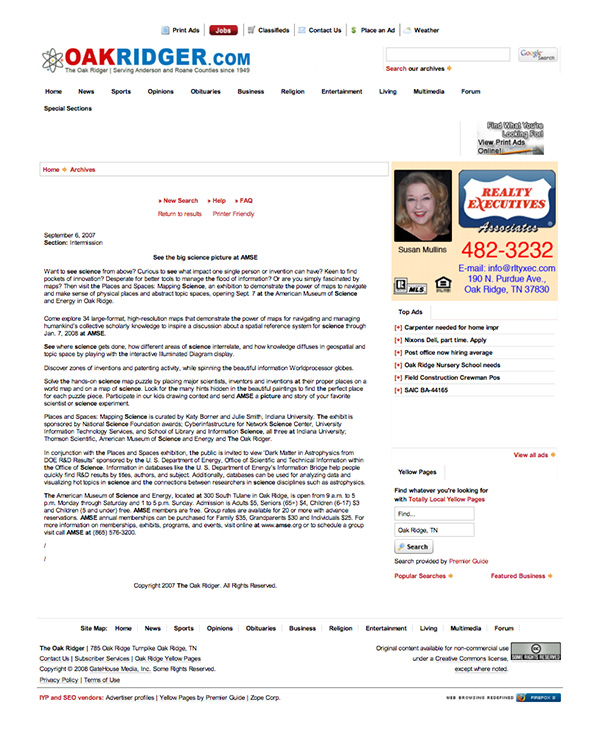See the Big Science Picture at AMSE
| The Oak Ridger

The following is an article from OakRidger.com. Download a PDF of the original article here.
Want to see science from above? Curious to see what impact one single person or invention can have? Keen to find pockets of innovation? Desperate for better tools to manage the flood of information? Or are you simply fascinated by maps? Then visit the Places and Spaces: Mapping Science, an exhibition to demonstrate the power of maps to navigate and make sense of physical places and abstract topic spaces, opening Sept. 7 at the American Museum of Science and Energy in Oak Ridge.
Come explore 34 large-format, high-resolution maps that demonstrate the power of maps for navigating and managing humankind’s collective scholarly knowledge to inspire a discussion about a spatial reference system for science through Jan. 7, 2008 at AMSE.
See where science gets done, how different areas of science interrelate, and how knowledge diffuses in geospatial and topic space by playing with the interactive Illuminated Diagram display.
Discover zones of inventions and patenting activity, while spinning the beautiful information Worldprocessor globes.
Solve the hands-on science map puzzle by placing major scientists, inventors and inventions at their proper places on a world map and on a map of science. Look for the many hints hidden in the beautiful paintings to find the perfect place for each puzzle piece. Participate in our kids drawing context and send AMSE a picture and story of your favorite scientist or science experiment.
Places and Spaces: Mapping Science is curated by Katy Borner and Julie Smith, Indiana University. The exhibit is sponsored by National Science Foundation awards; Cyberinfastructure for Network Science Center, University Information Technology Services, and School of Library and Information Science, all three at Indiana University; Thomson Scientific, American Museum of Science and Energy and The Oak Ridger.
In conjunction with the Places and Spaces exhibition, the public is invited to view ‘Dark Matter in Astrophysics from DOE R&D Results” sponsored by the U. S. Department of Energy, Office of Scientific and Technical Information within the Office of Science. Information in databases like the U. S. Department of Energy’s Information Bridge help people quickly find R&D results by titles, authors, and subject. Additionally, databases can be used for analyzing data and visualizing hot topics in science and the connections between researchers in science disciplines such as astrophysics.
The American Museum of Science and Energy, located at 300 South Tulane in Oak Ridge, is open from 9 a.m. to 5 p.m. Monday through Saturday and 1 to 5 p.m. Sunday. Admission is Adults $5, Seniors (65+) $4, Children (6-17) $3 and Children (5 and under) free. AMSE members are free. Group rates are available for 20 or more with advance reservations. AMSE annual memberships can be purchased for Family $35, Grandparents $30 and Individuals $25. For more information on memberships, exhibits, programs, and events, visit online at www.amse.org or to schedule a group visit call AMSE at (865) 576-3200.





